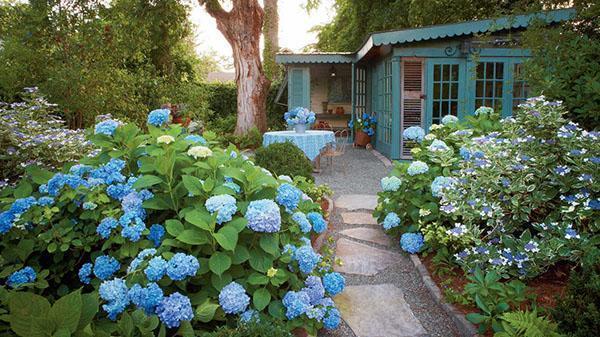We grow hydrangea in the garden: how to care for a shrub
 Among garden plants, hydrangea occupies a special place: the bush itself seems to be unremarkable and completely ordinary, but when the time of flowering comes and huge lush inflorescences begin to bloom one after another, you begin to understand how it earned the love of flower growers. To enjoy the flowering of hydrangeas every year, you should know how to care for it, how to fertilize and prune it, and where to plant it. What should you pay attention to and how to provide your beauty with comfortable conditions for development? Read about indoor hydrangea!
Among garden plants, hydrangea occupies a special place: the bush itself seems to be unremarkable and completely ordinary, but when the time of flowering comes and huge lush inflorescences begin to bloom one after another, you begin to understand how it earned the love of flower growers. To enjoy the flowering of hydrangeas every year, you should know how to care for it, how to fertilize and prune it, and where to plant it. What should you pay attention to and how to provide your beauty with comfortable conditions for development? Read about indoor hydrangea!
Where to plant?
One of the main conditions for hydrangea flowering is the right choice of planting site. Although some sources indicate that the plant is shade-tolerant, it has been observed from practice that in the shade the bush will not be able to fully reveal its beauty: the shoots will be thin and elongated, and the brushes themselves will be small.
It is necessary to plant hydrangea in a sunny place, but it is desirable that the sun illuminates the selected area only in the morning. If the bush is in the sun all the time, this will lead to fading of the color of the buds and reduce the duration of flowering (they will fade faster).
As for the composition of the soil, the hydrangea is very fond of moist and acidic soil, therefore it is necessary to add to the planting hole peat, and the bush itself is mulched with the bark of conifers.
If you mulch a hydrangea with coniferous litter, you can “kill two birds with one stone”: the soil under the bush will keep moisture longer, and litter will give off its acid during decomposition.
How, what and when to fertilize?
Like any abundantly flowering plant, hydrangea needs regular feeding, but not too often. For the season, a double application is enough:
- the first time - when the bush starts growing (at the end of May - at the beginning of June);
- the second time - just before flowering.
The hydrangea does not need additional feeding at the end of summer: it itself lays flower buds quite well for the next year, if it is fertilized in the spring before that.
It is best to feed a flower with complex preparations:
- specially for hydrangeas;
- or for rhododendrons.
If it is not possible to purchase such preparations, you can feed the hydrangea with any nitrogen-containing fertilizer, but with obligatory acidification (for example, add alum).
When and how to prune?
The best time to prune hydrangeas is late autumn (late October - November), when the bush is preparing for wintering. When pruning shrubs, you need to take into account their varietal affiliation, because some species can be shortened by half, others - more than that, and still others cannot be touched at all, except for sanitary cutting, because they bloom on old shoots. In large tall varieties, you can leave shoots up to 1 m high, in dwarf ones - up to 30 cm.
The second time it is necessary to cut the hydrangea in the spring, removing all thin shoots, as well as those that are broken. A small haircut is needed by the bush again, in the middle of summer, - then it is worth removing the young shoots on the branches so that they do not take away strength, and all of it goes into buds. Once every 8 years, hydrangea is recommended to be rejuvenated by cutting off all the shoots almost completely.